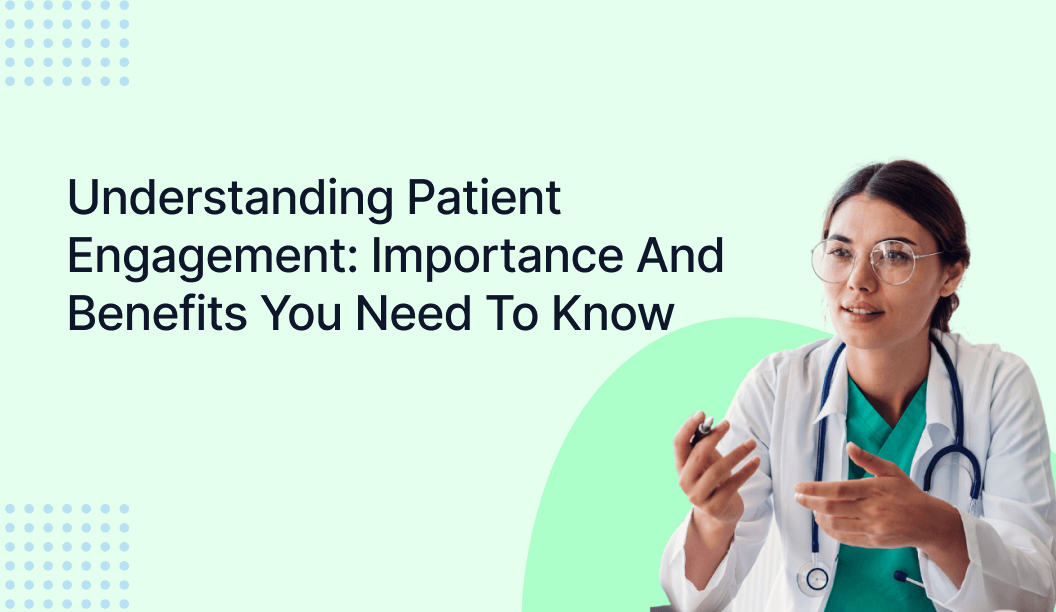Advancements in healthcare have revolutionized the way we perceive and treat ailments. With new technologies, treatments, and medical breakthroughs, healthcare has become more accessible, affordable, and efficient. However, patient engagement remains critical in delivering high-quality healthcare despite all these advancements.
Patient engagement encompasses a range of activities, from education and communication to shared decision-making and self-management. It leads to more efficient healthcare delivery, reduced healthcare costs, and improved patient safety.
Over 50% of patients use technology to communicate with their healthcare providers. Research indicates that patients have a healthier outcome when participating actively in their healthcare process. Hence providers need to acknowledge the goals and benefits of patient engagement and then draw out a strategy.
This Blog Includes:
What is patient engagement?
Patient engagement is the active participation of patients in their healthcare journey. It involves patients and healthcare providers working together to make informed decisions about the patient’s care. As per WHO (World Health Organisation), patient engagement is integral to patient care.
One key aspect of patient engagement is education. Healthcare providers can help patients become more informed about their health by providing accurate and understandable information about their condition, treatment options, and self-management strategies. This can help patients make more informed decisions about their care and feel more confident in managing their health.
Communication is another essential aspect of patient engagement. Healthcare providers can facilitate patient communication by actively listening to their concerns and providing clear and timely feedback. Patients who feel heard and understood are more likely to be engaged in their care and actively make decisions about their health.
In essence, patient engagement enables your patients to manage their health proactively. It can include:
- Researching the treatment options, diagnosis, and symptoms
- Following provider instructions and prescriptions
- Navigate healthcare system
- Collaborate with physicians and specialists
Also Read: Technology Updates for Patient Engagement
Why is patient engagement vital in healthcare?
Studies show us that higher patient engagement yields better results. Patients with a more collaborative relationship with their providers tend to form a more assertive commitment to their treatment and healing process.
Patient engagement is an essential component of the healthcare system because:
Better patient satisfaction:
The role of patient engagement is to improve patient satisfaction by employing the right technology and empowering the patients. Their involvement and understanding in the care process significantly build their satisfaction level compared to unengaged patients.
Improved health outcomes:
When patients are engaged in their healthcare, they are more likely to follow their treatment plans, manage their conditions effectively, and actively maintain their health. This can lead to better health outcomes and a higher quality of life.
Cut down costs and waste:
When patients are engaged in their care and actively manage their health, they are less likely to require costly interventions and hospitalizations. This can lead to lower healthcare costs and a more efficient healthcare system.
Better healthcare delivery:
Patients who participate in their care allow physicians to work more effectively to establish individualized treatment plans suited to their specific requirements and preferences. It creates a potential to improve the effectiveness and efficiency of healthcare delivery.
Benefits of patient engagement
Patient engagement is a key factor in achieving a patient-centered healthcare system that focuses on meeting each patient’s unique needs and preferences. It can improve health outcomes, increase patient satisfaction, lower healthcare costs, enhance patient education, and improve communication between patients and healthcare providers.
- Improved care reduces emergency care visits as patients actively engage in their well-being and healthcare choices.
- Increases patient satisfaction when patients are provided educational material to learn about their condition and treatment.
- Providers can make better treatment plans by collaborating with patients, strengthening patient retention.
- Providers can increase revenue by decreasing your no-show rates.
- It makes practice more efficient and effective with patient engagement practices like appointment scheduling, appointment reminders, text communication, remote patient monitoring and wearables, digital patient portals, and resource materials for patient knowledge and understanding.
To implement patient engagement, healthcare providers should consider adopting patient education, shared decision-making, patient portals, and patient feedback mechanisms.
These strategies can help providers to involve patients in their care, improve patient-provider communication, and build trust between patients and healthcare providers. By prioritizing patient engagement, healthcare providers can create a patient-centered healthcare system, focusing on patients’ needs and preferences.



